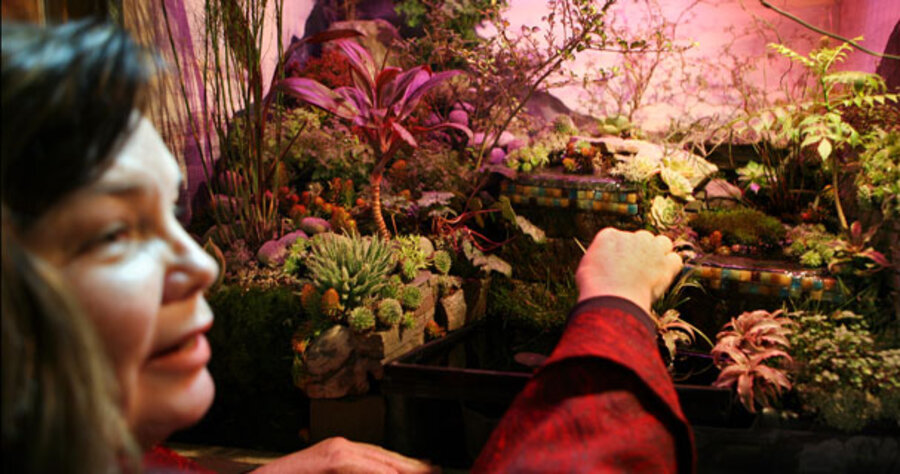Little gardens make a big impact
Loading...
Water cascades in graceful ribbons over ledges of stonework edged in mosaic tile. The pink-and-green-striped leaves of earthstar, a member of the pineapple family, form broad clumps along the water's edge. A lily pad floats in the glassy pool of this semitropical landscape.
The only thing unusual about this garden, a mixture of geometric precision and free-form exotic plants, is its scale. The entire landscape, at a scale of 1 inch equals 1 foot, fits inside a box the size of a packing crate.
Miniature gardens form part of the competition each year at the New England Spring Flower Show. Visitors of all ages can imagine what it would be like to play "Honey, I Shrunk the Kids" and enter these intricate landscapes. The designers use living plants rooted in tiny, soil-filled plastic bags and held in place by carved chunks of plastic foam. The foam is painted or masked by pebbles or tiny ground covers. Set into cabinets at eye level, these landscapes are viewed through a glass door, enhancing the secret-garden effect.
Warren Leach and Debi Hogan have elevated miniature gardens to a singular art form. The husband-and-wife team has created diminutive landscapes inspired by a 14th-century Chinese scholar's garden and the work of American landscape architect Fletcher Steele (1885-1971).
This year, they paid homage to Brazil's Roberto Burle Marx (1909-1994), who designed the Copacabana promenade in Rio de Janeiro and created signature public spaces in the country's capital, Brasília.
Mr. Leach and Ms. Hogan bring a knowledgeable, decidedly ungimmicky approach to miniature gardens, which is reflected in the blue ribbons they win each year. While other gardens in the show may be charming and meticulously assembled, they can't touch those of Leach and Hogan, with their attention to scale, detail, and historic style.
Leach may have a leg up on the competition: He has a degree in landscape design from the University of Maine and is part owner of Tranquil Lake Nursery in Rehoboth, Mass., near the Rhode Island border.
Hogan's background as an educator shows in her focus on educating the public about a particular landscape architect or period being demonstrated.
The couple starts thinking about the miniature garden they'll create for the flower show during winter when the nursery business slows down, with Leach sketching his idea on paper first. Throughout the year, they collect accessories and grow a variety of plants in the greenhouse.
Leach approaches the design of a miniature garden in the same manner he would a full-size garden. "I pretend the garden goes somewhere," he says. Rather than use the parameters of the box (or the property) to delineate his boundaries, he sees the paths and plantings as a continuation, as if you were looking at a series of panoramic photos and focused on one photo out of the series.
To enhance the illusion of depth, he places fine-textured plants toward the back and adds larger, coarse-textured ones in front. The pitfall of miniatures, he says, is being too literal, either with the structures or plants.
The couple chose to do a Burle Marx-inspired garden in part because Burle Marx was an early conservationist (he urged protection of the Amazon) and an advocate of plants native to Brazil. His skills as a painter come through in the sweeps of colorful foliage that dominate his designs and in the sculptural effect of his fountains.
This year, Leach's challenge was engineering the waterfalls, which were supplied by a recirculating pump. The entire garden had to be contained inside a plastic bin, to prevent water from leaking into the cabinet.
Leach reused part of the stonework from the Steele garden and repainted the background of the Chinese garden with an impressionistic mountain scene to represent Brazil. They set everything up at home but don't assemble the pieces until the show.
The couple say they make miniature gardens for the sheer fun of it; the modicum of recognition they receive is a bonus. Hogan enjoys watching people line up to peer inside the case. "We like to come and just look at it ourselves," she says.





